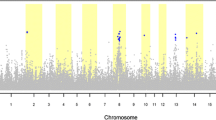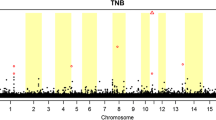Abstract
Anal atresia is a relatively common congenital malformation that occurs in about 1 out of 5000 infants, caused by abnormal hindgut development of the embryo, often associated with other developmental anomalies (e.g., Currarino, Townes–Brock, Pallister–Hall syndromes, and VATER association). Genetic analysis in human families is exceedingly difficult due to the multifactorial nature of the trait. In pigs, anal atresia occurs at a higher incidence (0.18%) than in humans. A complete genome scan (165 microsatellite markers) was performed using a backcross pedigree previously obtained by crossing affected animals from a partially inbred line, selected for a high incidence of anal atresia, with an unaffected male of a different breed (Meishan). The data set was analyzed with classical linkage (TWOPOINT) and nonparametric genetic methods (NPL, Non-Parametric Linkage, and TDT, Transmission Disequilibrium Test). Both methods support association of the trait with two loci on Chromosomes 9 and 15. GLI2 (GLI-Kruppel family member GLI2) was identified as a positional candidate gene based on comparative mapping; radiation hybrid mapping confirmed that this locus is located within the QTL region.
Similar content being viewed by others
References
EM Campbell SC Fahrenkrug JL Vallet TP Smith GA Rohrer (2001) ArticleTitleAn updated linkage and comparative map of porcine chromosome 18 Anim Genet 32 IssueID6 375–379
GJ Evans E Giuffra A Sanchez S Kerje G Davalos et al. (2003) ArticleTitleIdentification of quantitative trait loci for production traits in commercial pig populations Genetics 164 IssueID2 621–627
Green P, Falls K, Crook S (1990) Documentation for CRIMAP, version 2.4, Washington University School of Medicine, St Louis, MO, USA
T Hori E Giuffra L Andersson H Ohkawa (2001) ArticleTitleMapping loci causing susceptibility to anal atresia in pigs, using a resource pedigree J Pediatr Surg 36 1370–1374
SM Kiefer KK Ohlemiller J Yang BW McDill J Kohlhase et al. (2003) ArticleTitleExpression of a truncated Sall1 transcriptional repressor is responsible for Townes–Brocks syndrome birth defects Hum Mol Genet 12 IssueID17 2221–2227
AP Klein I Kovac AJ Sorant A Baffoe–Bonnie BQ Doan et al. (2003) ArticleTitleImportance of sampling method of correction for multiple testing in affected sib-pair linkage analysis BMC Genet 4 IssueIDSuppl 1 S73
D Kluth W Lambrecht P Reich C Buhrer (1991) ArticleTitleSD-mice–an animal model for complex anorectal malformations Eur J Pediatr Surg 1 IssueID3 183–188
J Kochling M Karbasiyan A Reis (2001) ArticleTitleSpectrum of mutations and genotype–phenotype analysis in Currarino syndrome Eur J Hum Genet 9 599–605
L Kruglyak MJ Daly MP Reeve–Daly ES Lander (1996) ArticleTitleParametric and non-parametric linkage analysis: a unified multipoint approach Am J Hum Genet 58 IssueID6 1347–1363
Y Kubota T Shimotake N Iwai (2000) ArticleTitleCongenital anomalies in mice induced by etretinate Eur J Pediatr Surg 10 248–251
Y Lahbib–Mansais M Yerle P Pinton J Gellin (1996) ArticleTitleChromosomal localization of homeobox genes and associated markers on porcine chromosomes 3, 5, 12, 15, 16 and 18: comparative mapping study with human and mouse Mamm Genome 7 IssueID3 174–179
E Lander L Kruglyak (1995) ArticleTitleGenetic dissection of complex traits: guidelines for interpreting and reporting linkage results Nat Genet 11 IssueID3 241–247
L Marklund JT Jeon L Andersson (1998) ArticleTitleXenoduplex analysis—a method for comparative gene mapping using hybrid panels Genome Res 8 IssueID4 399–403
R Mo JH Kim J Zhang C Chiang C Hui et al. (2001) ArticleTitleAnorectal malformations caused by defects in Sonic Hedgehog signaling Am J Pathol 159 765–774
H Okhawa T Hori (1997) ArticleTitleNaturally occurring pig model of anorectal malformations Jpn J Pediatr Surg 29 211–216
RS Spielman RE McGinnis WJ Ewens (1993) ArticleTitleTransmission test for linkage disequilibrium: the insulin gene region and insulin-dependent diabetes mellitus (IDDM) Am J Hum Genet 52 IssueID3 506– 516
EH Villavicencio DO Walterhouse PM Iannaccone (2000) ArticleTitleThe sonic hedgehog-patched-gli pathway in human development and disease Am J Hum Genet 67 IssueID5 1047–1054
M Yerle G Echard A Robic A Mairal C Dubut–Fontana et al. (1996) ArticleTitleA somatic cell hybrid panel for pig regional gene mapping characterized by molecular cytogenetics Cytogenet Cell Genet 73 IssueID3 194–202
Ackowledgments
This work was supported by the Fondazione Cariplo, Milan, by the Fondazione Parco Tecnologico Padano, Lodi (Italy), and by the Ministry of Education, Science, Sports and Culture (Japan), Grant-in-Aid for Scientific Research (C), 16591781, 2004. We thank Max Rothschild (US Pig Genome Coordinator, NRSP-8) for providing microsatellite primers, Paul Boettcher and Alan Archibald for the support in statistical analyses, and Susan Anderson for revision of the manuscript.
Author information
Authors and Affiliations
Corresponding author
Rights and permissions
About this article
Cite this article
Cassini, P., Montironi, A., Botti, S. et al. Genetic analysis of anal atresia in pigs: evidence for segregation at two main loci. Mamm Genome 16, 164–170 (2005). https://doi.org/10.1007/s00335-004-3024-6
Received:
Accepted:
Issue Date:
DOI: https://doi.org/10.1007/s00335-004-3024-6




